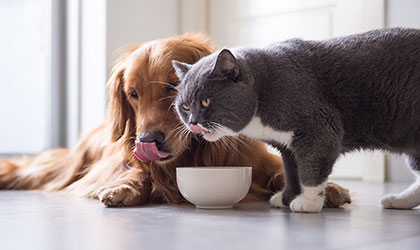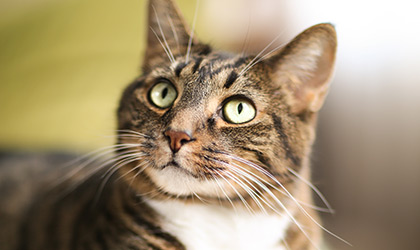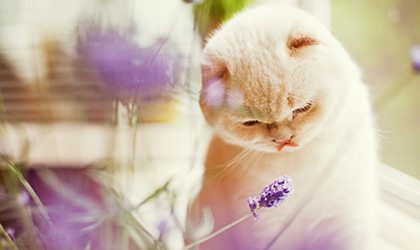
As your feline friend enters her golden years, it’s very possible she may become an indoor lap potato, a serial cat-napper, or even a quivering mess without the reassurance of affection (awww). But it’s not all downhill. Often, people choose to adopt older cats by virtue of them spending less time roaming and more time closer to home, facilitating a special bond. In many respects, they are pretty purr-fect companions.
As kitty ages, you need to up the ante as her owner. Her grooming, nutrition and lifestyle demands will change, and you have to be prepared to cater to them. You’ll need to keep your eagle eye on her too. Felines have an uncanny ability to hide their symptoms and suffering, so it’s important to watch for certain clues to detect illness. But, as every cat person understands, all it takes is one glance at that irresistibly adorable face to know she’s entirely worth it.
The ageing process
Once kitty hits the ripe age of twelve years old, she’s earned her stripes as a ‘senior’. At this point, you’ll notice your little fur ball taking life a little easier – and who can blame her? She is pushing sixty in human years, after all! You can expect to see some of the following changes.
-
Her fluid intake and appetite may fluctuate
-
Her hearing and vision may become less effective
-
Her activity levels will decrease, along with her muscle tone
-
Her urinary system and bowel functions may change
-
Her coat could deteriorate
-
She may develop age-related health problems such as mobility issues
-
She may experience behavioural and psychological issues such as aggression, increased dependence, senility or excessive vocalisation
Nutrition
Dietary requirements
It’s no secret that proper nutrition lays the groundwork for a life abundant happiness, health and longevity. And feeding kitty the right food is more important than ever in her senior years. Not only will a well-balanced food regimen keep her trim and avoid straining stiffening joints, but it will keep her bodily functions in good, working order. An optimal diet for your furry friend is one that consists of controlled levels of fat, concentrated, high-quality protein, and easy-to-digest carbs. It should also boast essential minerals to support mobility (say hello to our friends’ calcium, magnesium and phosphorus), and antioxidants to support the immune system.
As your four-pawed pal enters old age, you should start feeding her a specifically formulated ‘senior’ food, instead of her usual ‘adult’ variety – be it wet or dry. This will provide a hit of quality protein, along with a strong dose of vitamin E to reinforce the body’s natural defences. Above all, this food contains fewer calories than its ‘adult’ counterpart, which is vitally important for maintaining a healthy body weight in old age, especially because most elderly cats ditch physical activity in favour of their preferred snoozing spot.
Since older cats can experience a host of health problems, admittedly, it can be difficult to find a winning cat food formula to meet their individual needs. Supplementation may be worth considering. And a high-strength multivitamin and an omega-3 combination is a stellar option if you don’t already have it in your arsenal. This power-duo will help plug any nutritional gaps your feline may encounter from commercial food alone. While the multi will deliver antioxidants, trace minerals and vitamins for teeth-to-tail nourishment, the essential fatty acids from the omega 3 will support mobility, vision and skin. If kitty has mobility problems, you may also want to consider glucosamine, which can provide some much-needed support.
Feeding routine
As always, you should introduce any new food gradually. Failure to do so could result in your finicky feline turning his nose up at it entirely, or even suffering with uncomfortable digestive issues. Start by offering the new food in your friend’s regular bowl, and place his old food in a different bowl (the ratio should be 25% new food vs. 75% old food). Slowly change the portions over the next three days, gradually increasing the amount of the new food and decreasing the old food. At the end of the weaning process, you should be feeding your furry pal 100% new food and everyone should be happy!
Older cats may feel overwhelmed by sizeable meals, so you should feed them little and often throughout the day (ahem, never offer kitty an ‘all-day-buffet’ either, as this a sure-fire gateway into weight issues!) The manner in which you serve meals plays its part too. Felines are creatures of habit, so aim to feed them in the same quiet spot at the same time every day. Offer food in a wide, shallow ceramic bowl – one that doesn’t brush up against kitty’s whiskers – with plenty of fresh water nearby. Oh, and never put kitty’s dinner near his litter tray; he will only disregard food near his toilet site.
Quantity
Food packaging guidelines can help you gauge a rough amount of how much to feed kitty, but remember, this is only a rough approximation. Every cat is different and will have varying needs to remain in fighting-fit condition. Err on the side of caution and ask your vet to calculate the exact number of calories your furry friend needs each day.
Weight management
In old age, it’s common for your feline’s weight to fluctuate. As her activity levels drop and her avid love for napping increase, kitty may pack on the pounds. But the sight of a potbelly isn’t anything to coo or gush at, regardless of how cute you think it is. Sadly, overweight and obese cats are much more likely to develop mobility problems, urinary issues and even diabetes, so you must take it seriously. Weigh your companion regularly and if you notice she’s a little heavier than usual, have a word with your vet. Or, while you’re here, why not head over to our article on ‘Diet Tips for Cat’s’ for more weight loss tips?
Equally, losing weight is another phenomenon that can happen in kitty’s senior years. Not only can changes to your little fur ball’s sense of smell and taste affect her appetite, but her maturing digestive system and metabolism could also impact the way she processes and absorbs food. If you notice your cat is off her food, consult your vet as this may signal illness. But if your vet is certain there’s no underlying health concern affecting her appetite, there are nifty hacks to restore her interest in food.
-
Add a small amount of tuna to each meal to awaken her senses
-
Vary the texture and flavour of the food you give her
-
Warm the food to room temperature to release its aroma
Grooming
Brushing
As age takes its toll on your four-pawed friend, she may let herself go on the grooming front, meaning you’ll need to step up to the mark. Daily brushing is essential to keeping your feline happy, healthy and smelling like roses (well, almost). Grooming removes loose hairs from kitty’s coat, thereby preventing them from being ingested and forming unpleasant hairballs (eeek!) It also stimulates sebaceous gland secretions and blood circulation, leaving behind an oh-so-huggable coat. Brushing kitty is perfect bonding time too.
Claws
Since older cats may not use scratching posts as much these days, they will need their claws trimmed every week to avoid becoming thick and ingrown. Don’t feel guilty if you can’t do this yourself; it can be a fiddly job, especially if you have a nervy cat on your hands. Ask your veterinarian or groomer for advice about what types of nail trimmers are best and how to use them properly.
Dental hygiene
Daily teeth brushing can reduce a build-up of plaque and the pong of bad breath, which is a common occurrence in old age (and can leave even the most doting owners gasping for air!) Always opt for a specifically formulated toothpaste and toothbrush, and ask your vet for guidance before you begin. Disclaimer: never use human toothpaste because it contains harmful chemicals that will make kitty sick.
Lifestyle
Supporting your older cat in the home
Creating a low-stress environment can support your furry friend in her golden years. Put down secure rugs to help older cats as they walk; offer plenty of cosy, well-padded beds in safe, warm places (pssst…a hammock-style radiator bed is a paws-down winner); provide ramps or a small footstool for access to high places (don’t forget cats love perching in elevated nooks and crannies); and provide several litter trays and water bowls around the house. This is the stage in life where a good ol’ dose of TLC goes a long way too. A professional animal massage therapist may support kitty’s circulation, flexibility, and mobility. There…that’s better.
Playtime
Even in old age, physical activity – albeit in small doses – is a must for your feline friend. To coax your elderly friend off the sofa, exploit her predatory nature with toys that aren’t likely to startle or intimidate her, such as a feather or a piece of string. Though older cats won’t have the stamina for extended play sessions, they can still manage and enjoy short bursts of exercise.
Final thoughts
While proper nutrition, grooming and lifestyle changes will certainly work wonders at supporting your golden oldie, sometimes old age can get the better of pets. Felines, in particular, are masters of disguise. They can hide a serious illness, even if it’s fairly advanced, so you need to become an expert at reading their body language. Bottom line: if your cat seems to be lively, happy and healthy, and she has clear eyes and a silky-soft coat, then there’s usually little cause for concern. But if you suspect otherwise, it’s always best to speak with your vet.
References:
-
Blue Cross. (2018). Caring for the older cat. Available online: https://www.bluecross.org.uk/pet-advice/caring-older-cat
-
Cats Protection. (2018). Elderly Cats. Available online: https://www.cats.org.uk/uploads/documents/cat-care-leaflets-2013/EG16_Elderly_cats.pdf
-
Pets4Homes. (2018). Caring for older cats. Available online: https://www.pets4homes.co.uk/pet-advice/caring-for-older-cats.html



